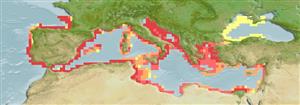Common names from other countries
Teleostei (teleosts) >
Callionymiformes (Dragonets) >
Callionymidae (Dragonets)
Etymology: Callionymus: Greek, kallion, comparative of kallos = beautiful + Greek, onyma = name; with a better name .
More on author: Lesueur.
Environment: milieu / climate zone / depth range / distribution range
Ecology
Marine; demersal; depth range 15 - 150 m. Subtropical; 46°N - 31°N, 10°W - 36°E
Eastern Atlantic: northern Mediterranean, from Gibraltar to the coast of Israel, including the Adriatic, Aegean and western and northern Black Sea; also Algeria and Tunisia. Rarely seen off Portugal.
Size / Weight / Age
Maturity: Lm ? range ? - ? cm
Max length : 18.2 cm TL male/unsexed; (Ref. 88088); common length : 4.0 cm male/unsexed; (Ref. 3397); max. published weight: 38.60 g (Ref. 88088)
Found on sandy bottoms in shallow coastal waters. Feeds on small bottom invertebrates, mainly worms and crustaceans. Oviparous, eggs and larvae are pelagic.
Life cycle and mating behavior
Maturities | Reproduction | Spawnings | Egg(s) | Fecundities | Larvae
Fricke, R., 1986. Callionymidae. p. 1086-1093. In P.J.P. Whitehead, M.-L. Bauchot, J.-C. Hureau, J. Nielsen and E. Tortonese (eds.) Fishes of the North-eastern Atlantic and the Mediterranean. UNESCO, Paris. Vol. 3. (Ref. 5968)
IUCN Red List Status (Ref. 130435)
CITES (Ref. 128078)
Not Evaluated
Threat to humans
Harmless
Human uses
Fisheries: subsistence fisheries
Tools
Special reports
Download XML
Internet sources
Estimates based on models
Preferred temperature (Ref.
115969): 13.1 - 18.7, mean 14.8 (based on 118 cells).
Phylogenetic diversity index (Ref.
82804): PD
50 = 0.5000 [Uniqueness, from 0.5 = low to 2.0 = high].
Bayesian length-weight: a=0.00851 (0.00662 - 0.01094), b=2.76 (2.71 - 2.81), in cm Total Length, based on LWR estimates for this species (Ref.
93245).
Trophic level (Ref.
69278): 3.0 ±0.4 se; based on diet studies.
Resilience (Ref.
120179): Medium, minimum population doubling time 1.4 - 4.4 years (Preliminary K or Fecundity.).
Fishing Vulnerability (Ref.
59153): Low vulnerability (10 of 100).
